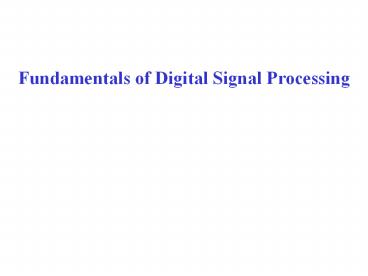Fundamentals of Digital Signal Processing - PowerPoint PPT Presentation
Title:
Fundamentals of Digital Signal Processing
Description:
Fundamentals of Digital Signal Processing Fourier Transform of continuous time signals with t in sec and F in Hz (1/sec). Examples: Discrete Time Fourier Transform of ... – PowerPoint PPT presentation
Number of Views:3044
Avg rating:3.0/5.0
Title: Fundamentals of Digital Signal Processing
1
Fundamentals of Digital Signal Processing
2
Fourier Transform of continuous time signals
with t in sec and F in Hz (1/sec). Examples
3
Discrete Time Fourier Transform of sampled signals
with f the digital frequency (no dimensions).
Example
since, using the Fourier Series,
4
Property of DTFT
- f is the digital frequency and has no
dimensions - is periodic with
period f 1.
- we only define it on one period
5
Sampled Complex Exponential no aliasing
1. No Aliasing
digital frequency
6
Sampled Complex Exponential aliasing
2. Aliasing
digital frequency
7
Mapping between Analog and Digital Frequency
8
Example
- Then
- analog frequency
- FT
- digital frequency
- DTFT
for
9
Example
- Then
- analog frequency
- FT
- digital frequency
- DTFT
for
10
Example
- Then
- analog frequencies
- FT
- digital frequencies
- DTFT
11
Linear Time Invariant (LTI) Systems and
z-Transform
If the system is LTI we compute the output with
the convolution
If the impulse response has a finite duration,
the system is called FIR (Finite Impulse
Response)
12
Z-Transform
Facts
Frequency Response of a filter
13
Digital Filters
Ideal Low Pass Filter
constant magnitude in passband
and linear phase
passband
14
Impulse Response of Ideal LPF
Assume zero phase shift,
This has Infinite Impulse Response, non recursive
and it is non-causal. Therefore it cannot be
realized.
15
Non Ideal Ideal LPF
The good news is that for the Ideal LPF
16
Frequency Response of the Non Ideal LPF
ripple
attenuation
pass
stop
stop
transition region
- LPF specified by
- passband frequency
- passband ripple or
- stopband frequency
- stopband attenuation or
17
Best Design tool for FIR Filters the Equiripple
algorithm (or Remez). It minimizes the maximum
error between the frequency responses of the
ideal and actual filter.
ripple
attenuation
impulse response
Linear Interpolation
18
- The total impulse response length N1 depends on
- transition region
- attenuation in the stopband
Example we want Passband 3kHz Stopband
3.5kHz Attenuation 60dB Sampling Freq 15
kHz Then from the specs We determine the order
the filter
19
Frequency response
N82
N98
20
Example Low Pass Filter
Passband f 0.2 Stopband f 0.25 with
attenuation 40dB Choose order N40/(22(0.25-0.20)
)37
Almost 40dB!!!
21
Example Low Pass Filter
Passband f 0.2 Stopband f 0.25 with
attenuation 40dB Choose order N40 gt 37
OK!!!
22
General FIR Filter of arbitrary Frequency Response
Weights for Error
Then apply
and always check frequency response if it is
what you expect!
23
Example
for
fp00.010.2 vector of
passband frequencies fs0.25,0.5
stopband frequencies M1./sinc(fp), 0,
0 desired magnitudes Df0.25-0.2
transition region Nceil(A/(22Df)
) first guess of order hfirpm(N,
fp, fs/0.5,M) impulse response
24
not very good here!
25
- To improve it
- Increase order
- Add weights
w1ones(1,length(fp)/2), 0.2ones(1,
length(fs)/2) hfirpm(N, fp, fs/0.5,M,w)
26
(No Transcript)































